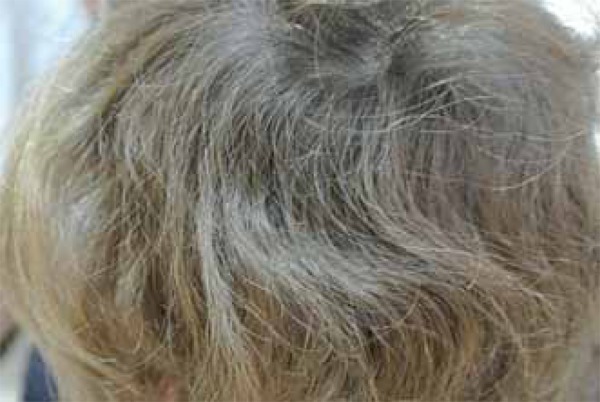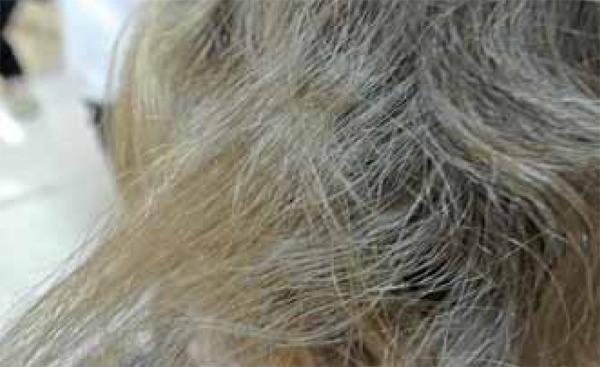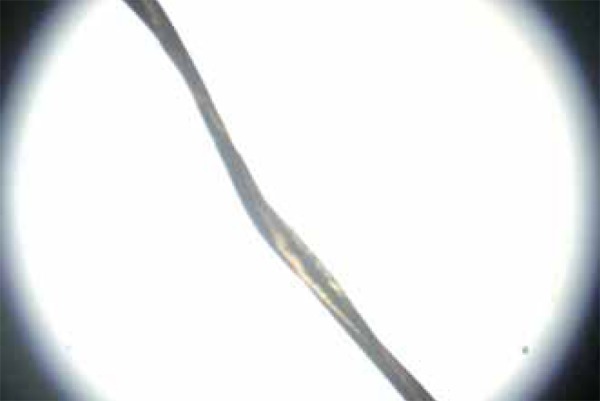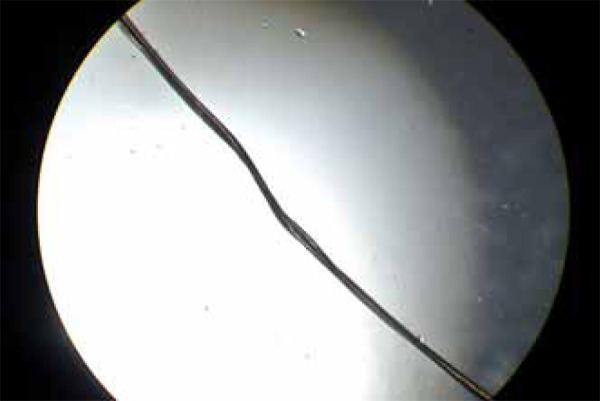Abstract
Pili torti also known as ‘twisted hairs’ (Latin: pili=hair; torti=twisted) is a rare, congenital or acquired clinical presentation, in which the hair shaft is flattened at irregular intervals and twisted 180º along its axis. It is clinically characterized by fragile, brittle, coarse and lusterless hairs, due to uneven light reflection on the twisted hair surface. Pili torti may be associated with neurological abnormalities and ectodermal dysplasias. There is no specifi c treatment for this condition, but it may improve spontaneously after puberty. We report a case of pili torti in a child who presented fragile, brittle, diffi cult to comb hair. The patient had no comorbidities.
Keywords: Capillary fragility, Hair diseases, Rotation
INTRODUCTION
Pili torti is a congenital or acquired, dominant autosomal disease in which the hair shaft is flattened at irregular intervals and twisted along its axis. It most commonly occurs in fair-haired girls, beginning in the second or third year of life. The hairs become dry, lusterless, fragile and brittle. The condition may be associated with neurosensorial deafness1 and is probably caused by changes in the internal hair sheath.
CASE REPORT
A 6-year-old, white, female patient with light brown hair reported 1-year history of difficulty in combing her hair and the appearance of weak and brittle hair strands. The child had age-adequate psychomotor development and no history of illness and hospitalization. She denied similar cases in the family. Dermatological examination revealed thick, coarse and brittle hair in the left occipitotemporal region (Figures 1 and 2). The skin and its annexes showed no abnormalities. Polarized light microscopy revealed a flattened hair shaft, twisted 180º along its axis at irregular intervals (Figures 3 and 4). Neurological evaluation, audiometry and measurement of serum zinc were performed. All results were within the normal range. The diagnostic hypothesis of pili torti was made. The patient remains in outpatient follow-up and shows age-appropriate neuropsychomotor development.
FIGURE 1.

Pili torti. Lusterless, opaque, scarce blond hair.
FIGURE 2.

Pili torti. Thick, coarse and brittle hair in the left occipitotemporal region.
FIGURE 3.

Pili torti. Polarized light microscopy, 10x magnifi cation: Flattened hair shaft, twisted 180º along its axis at irregular intervals
FIGURE 4.

Pili torti. Polarized light microscopy, 10x magnifi cation: Hair twisted about its longitudinal axis
DISCUSSION
The first cases of pili torti were published in 1932 by Ronchese, who reported the isolated finding of twisted hairs in two young blond-haired sisters.2 Since then, pili torti has been linked with a wide array of congenital defects, including leukonychia, dental abnormalities, keratosis pilaris, dystrophic nails, and ichthyosis.3 A review of the Online Mendelian Inheritance in Man® (OMIM) identified 19 entries for pili torti. The more common congenital defects and syndromes associated with pili torti include Beare syndrome (scarce beard and body hair, alopecia after puberty in African descent individuals); Ronchese syndrome (leukonychia, ichthyosis, keratosis pilaris, nail dystrophy, and dental abnormalities); Björnstad Syndrome (sensorineural deafness), Menkes syndrome (growth retardation of early onset, focal brain degeneration); Rapp-Hodgkin syndrome (anhidrotic ectodermal dysplasia, cleft lip, cleft palate, hypodontia, nail abnormalities, hypospadias in males); trichodysplasia-xeroderma (skin xerosis, alopecia, hypotrichosis, trichorrhexis nodosa); and trichothiodystrophy (ichthyosis, developmental delay, brittle hair, including pili torti, and photosensitivity).1 Pili torti can also be acquired through the administration of oral retinoids and in scarring alopecia. However, the condition is more commonly localized than diffuse.
A wide range of changes associated with pili torti suggest specific pathophysiological mechanisms, which have irregular hair shafts as their common denominator. Morphological studies of its axis showed no abnormalities in the hair cortex keratin. The twisting of the hair is likely due to irregularities in the inner root sheath, which may induce an uneven molding of the hair shaft.4 In acquired pili torti, it is presumed that perifollicular fibrosis causes rotational forces that distort the hair follicle.3
Studies detailing the pathogenesis of pili torti and sensorineural hearing loss identified defects in the BCS1L gene. BCS1L gene mutations affect basic units for mitochondrial metabolism. In Björnstad syndrome, it seems to illustrate the sensitivity of auditory system tissues and hair to the role of the mitochondria.5 In Menkes Syndrome there is a mutation in the transport of copper, which is an essential element in the formation of disulfide bonds in hair keratin. Defective keratin production may cause twisting of the hair. Defects in copper transportation may lead to mitochondrial dysfunction and, consequently, affect the production of oxygen-reactive species.6 The cause of pili torti in the Menkes syndrome may be similar to the Björnstad syndrome.
If pili torti is detected, possible neurological disorders, hearing loss, and ectodermal disturbances need to be assessed.
In order to make the diagnosis of pili torti, the hair, which is break-prone in the distal hair shaft, is placed on a glass slide and examined by light microscopy. Features such as twisted, thin hair distinguish this disease from typical curly/kinky hair and other causes of hair fragility and breakage. hair shaft is flattened at irregular intervals and twisted 180º along its axis. Each twist is 0.4-0.9 mm wide and occurs in groups of 3 to 10.3,7 The twisted hair is fragile and easily brittle on the scalp.4 Blond hair tends to be scarce, opaque, lusterless, due to the uneven light reflection of the twisted hair surface. Due to friction, areas of alopecia and coarse stubble are more common in the occipital and temporal areas.7 Pili torti can also be detected in the eyebrows, eyelashes and armpits.8
There is no specific treatment for pili torti. It may improve spontaneously after puberty. If pili torti is detected, further evaluation to investigate possible neurological disorders, ectodermal disturbances and hearing loss is mandatory.1 In the case of our patient, we did not identify any changes. The patient remains in outpatient follow-up and shows good psychomotor development.
Footnotes
Financial Support: None.
How to cite this article: Yang JJH, Cade KV, Rezende FC, Pereira JM, Pegas JRP. Clinical presentation of pili torti - Case report. An Bras Dermatol. 2015;90(3 Suppl 1):S29-31.
Study conducted at the Padre Bento Hospital Complex (CHPBG) - Guarulhos (SP), Brazil.
References
- 1.Mirmirani P, Samimi SS, Mostow E. Pili torti: clinical findings, associated disorders, and new insights into mechanisms of hair twisting. Cutis. 2009;84:143–147. [PubMed] [Google Scholar]
- 2.Ronchese F. Twisted hairs (pili torti) Arch Derm Syphilol. 1932;26:98–109. [Google Scholar]
- 3.Whiting DA. Hair shaft defects. In: Olsen EA, editor. Disorders of Hair Growth: Diagnosis and Treatment. 2nd ed. New York, NY: McGraw Hill; 2003. pp. 123–175. [Google Scholar]
- 4.Maruyama T, Toyoda M, Kanei A, Morohashi M. Pathogenesis in pili torti: morphological study. J Dermatol Sci. 1994;7:S5–12. doi: 10.1016/0923-1811(94)90029-9. [DOI] [PubMed] [Google Scholar]
- 5.Hinson JT, Fantin VR, Schönberger J, Breivik N, Siem G, McDonough B, et al. Missense mutations in the BCS1L gene as a cause of the Björnstad syndrome. N Engl J Med. 2007;356:809–819. doi: 10.1056/NEJMoa055262. [DOI] [PubMed] [Google Scholar]
- 6.Rossi L, Lombardo MF, Ciriolo MR, Rotilio G. Mitochondrial dysfunction in neurodegenerative diseases associated with copper imbalance. Neurochem Res. 2004;29:493–504. doi: 10.1023/b:nere.0000014820.99232.8a. [DOI] [PubMed] [Google Scholar]
- 7.Price V. Structural anomalies of the hair shaft: pili torti. In: Orfanos CE, Happle R, editors. Hair and Hair Diseases. Heidelberg, Berlin: Springer-Verlag; 1990. pp. 384–390. [Google Scholar]
- 8.Olszewska M, Rakowska A. Atlas of Trichoscopy Dermoscopy. London: Ed. Springer-Verlag; 2012. pp. 167–168. [Google Scholar]


